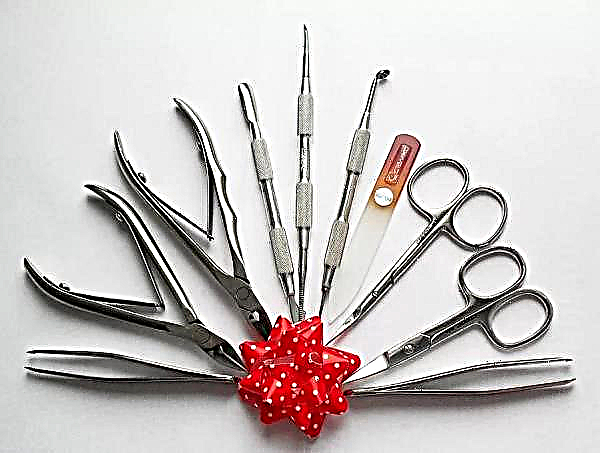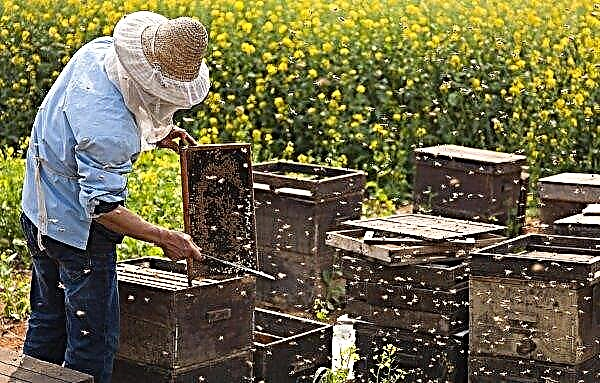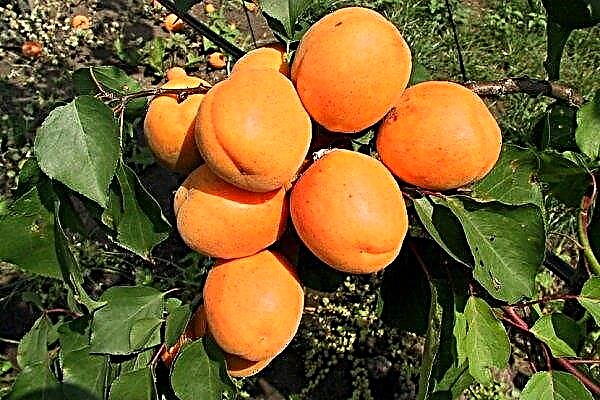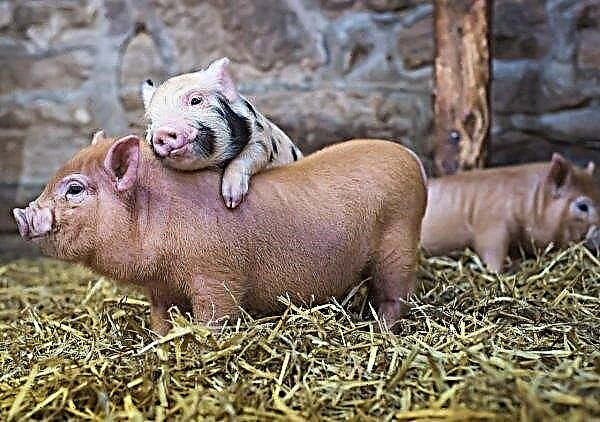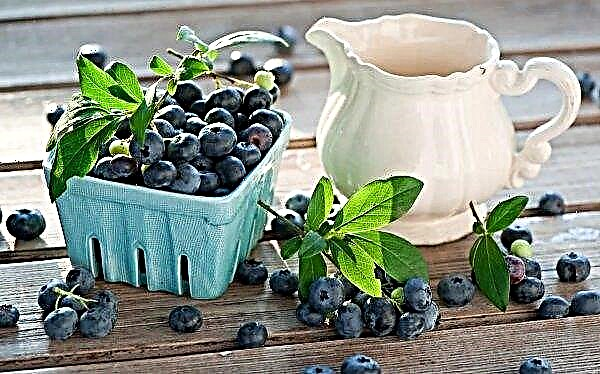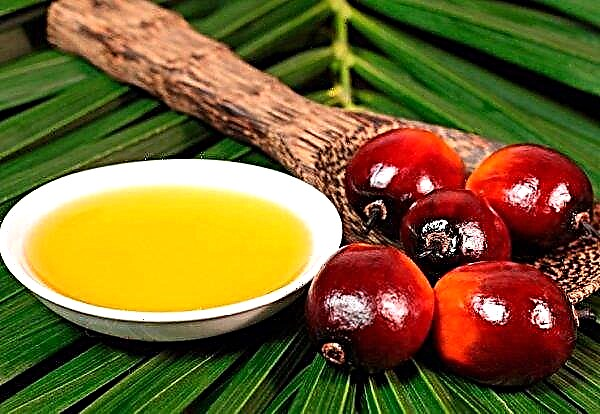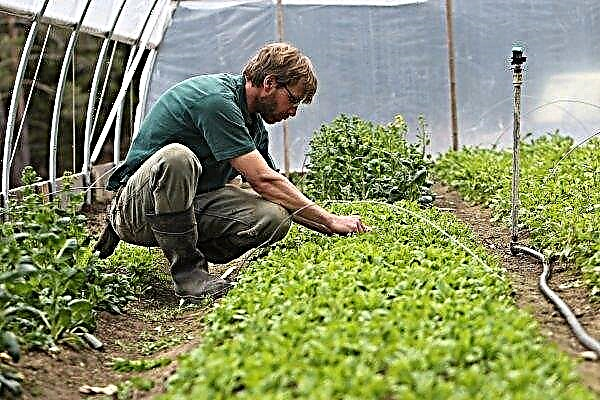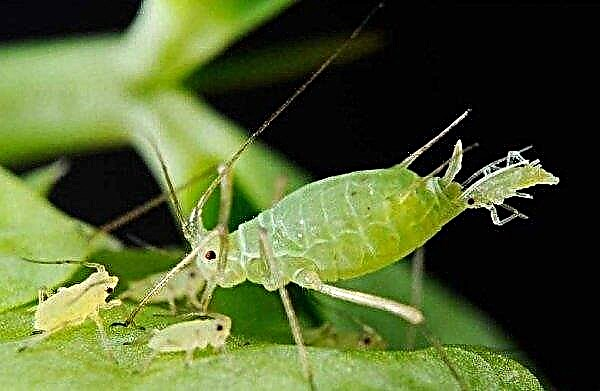A feature of early ripe cucumbers is the lack of bitterness in taste. Among the popular hybrids of this category, many vegetable growers prefer the Paratunka f1 variety, which is suitable for homestead and industrial cultivation. Its crop can be obtained on the open ground and in greenhouse conditions. What to do for a successful cultivation of culture, learn further from the article.
Grade description
For the first time, they started talking about Paratunka on the seed market in 2006, when the variety bred by the founder of the Semko-Junior agricultural company, Yuri Alekseev, was included in the State Register of Selection Achievements of the Russian Federation and allowed for cultivation in the North, North-West, Volga-Vyatka, Central, Middle Volga, North Caucasian and Central Black Earth regions of the country.
Did you know? In Iran, cucumbers are considered fruits, and therefore there is a tradition in the country to serve these fruits with sweets.
The hybrid does not require pollination, since it is characterized by a flowering female type, that is, it is parthenocarpic. It is characterized by early maturity and high productivity, as well as undemanding to growing conditions and quick adaptation to climate change. Cucumber bush is characterized by medium height and branching. Its central shoots are not limited to flower tassels. The foliage is bright green, medium in size. Fruits are cylindrical, medium tuberous with weak ribbing and a short neck.
Cucumber bush is characterized by medium height and branching. Its central shoots are not limited to flower tassels. The foliage is bright green, medium in size. Fruits are cylindrical, medium tuberous with weak ribbing and a short neck.
The average length of cucumbers is about 9 cm, diameter - about 3 cm, weight - not more than 100 g. Vegetable flesh is not hollow, characterized by a specific aroma and crunch, it tastes pleasantly sweet. The skin of Zelentsez is delicate dark green with medium hairiness and sharp light tubercles.
The fruits are suitable for consumption in a fresh, canned form, as well as for pickles and pickling.
When grown, the variety painlessly tolerates a sharp change in temperature, practically insensitive to powdery mildew, brown spotting and bacteriosis. Seeds give good germination, regardless of the structure of the substrate.
Advantages and disadvantages
- The hybrid is in great demand, due to its advantages:
- early maturity (the first crop can be harvested 40–45 days after planting);
- prolonged continuous bearing (Zelentsy ripen until the first frost);
- good quality, versatility and transportability of the fruit;
- undemanding to the conditions and place of cultivation (cucumbers can be sown both in the greenhouse and in the open ground);
- self-fertility (female-type flowers form an ovary without pollinators);
- satisfactory resistance of the variety to common diseases;
- high yields.
Judging by the reviews of vegetable growers regarding the cultivation of the crop, the quantity and quality of its harvest, Paratunka f1 has no shortcomings. However, consumers expressed their wishes for lower prices for planting material.
However, consumers expressed their wishes for lower prices for planting material.
Important! Cucumbers painfully endure drafts and cold. Therefore, when growing them in seedlings, it is better to place a container with sowing on a windowsill on a foam base, and cover the seedlings planted at a constant place with polyethylene in case of temperature drop.
Productivity
It is common for a hybrid to form 2-3 ovaries in each sinus. Under favorable temperature and humidity conditions for cultivating varieties, up to 16 kg of crop can be harvested from each square meter of the field. In cold regions, this figure will reach 11 kg.
For good fruiting, experts advise to observe the density of planting, focusing on 3-4 plants per 1 m².
Optimal landing times
Given the endurance of Paratunka, many vegetable growers practice a seedling and seedling method of growing it, but it is important to sow seeds in a timely manner. What are the advantages and disadvantages of each technologist and what terms are recommended for planting, find out from the table below.
| Seedling method | Reckless way | |
| Advantages | ultra early harvest | healthy, stronger, not elongated plants; reduction of labor costs and time |
| disadvantages | weakened plants; increased risk of morbidity; the possibility of damage to the root system during transplantation; in case of poor lighting, the elongation of the stems | yield reduction due to late fruiting |
| Recommended sowing dates | the beginning of June | second decade of May |

Ways to plant cucumbers
The Paratunka hybrid differs from other parthenocarpic varieties with an underdeveloped root system and too long lashes. These features are important to consider when planting crops.
Important! The presence of empty flowers on a cucumber bed indicates an illiterate planting plan.
Seedling method
Growing cucumbers in a greenhouse or under a film cover requires the preliminary preparation of planting material, substrate and appropriate containers. Even minor errors at each stage are fraught with a decrease in yield and quality of fruits.
Soil requirements and tank sizes
With seedling technology, cucumber seeds should be sown in peat pots measuring 10 × 10 cm. This will allow the hybrid root system to fully develop and protect it from possible damage during transplantation. These containers are also beneficial in that they do not require diving of grown seedlings.
Variety Paratunka f1 can adapt to any soil, but copious fruiting is possible provided the nutrient mixture.
Therefore, vegetable growers are advised to cook it from:
- high peat (2 hours);
- mature compost, as an alternative, vermicompost is suitable (2 hours);
- humus (2 hours);
- river sand (1 hour);
- sawdust (1 h.).
 After mixing all of the listed ingredients, you need to add to each bucket of soil mix:
After mixing all of the listed ingredients, you need to add to each bucket of soil mix:- urea (1 tsp);
- superphosphate (1 tsp);
- potassium sulfate (1 tsp);
- wood ash (1 cup).
Did you know? Cucumber, whose homeland is India, exists for about 6 thousand years.
Seed preparation
The rules of agricultural techniques for growing cucumbers in seedlings at the stage of seed preparation include the following:
- Calibration - the procedure consists in culling empty and unfit for sowing specimens. You can understand their quality by pouring grains with salt water. The solution is prepared in a proportion of 1 tbsp. l per 200 ml of water. Poor-quality material rises to the surface and is eliminated by draining the liquid.
- Soak - It is carried out in warm water with the addition of any growth stimulant ("Emistim", "Kornevin", "Ecosil", "Acrobat MC"). To improve germination, planting material should be in solution for at least 2-3 hours. If desired, the procedure can be carried out using folk remedies, preparing a nutrient liquid from 1 liter of warm water, as well as equal parts of wood ash and nitroammophoska.

Seed sowing technology
Cucumber seedlings at home are grown according to the instructions below:
- Put drainage (preferably made of expanded clay) into the prepared containers at the bottom and fill them with 2/3 of the substrate.
- Place the pots in a wide pan on the windowsill of the southern orientation and pour plenty of warm, settled water. After excess moisture seeps through the drainage holes, allow the soil some time to mature. Readiness comes when the earthen ball becomes crumbly and does not stick together.
- 2 cucumber kernels are placed in the middle of each container in the middle, slightly deepening them by 1.5 cm. This is done to secure germination. If you are confident in the quality of the seed, you can sow 1 copy of Paratunka.
- Then sprinkle inoculation with a layer of wet river sand or with the used soil mixture and compact the soil with your palms.
- Using a spray gun, moisten the contents of the landing container, then cover with plastic wrap or glass and leave it in a warm place.
Important! If it is necessary to disinfect cucumber seeds, in case of using potassium permanganate, do not overdo them in the solution. 15–20 minutes are enough for disinfection. Longer soaking is fraught with deterioration of germination.
Seedling Care
It is advisable to leave containers with cucumber grains in a pan. Before emergence, they must be in a room with a stable temperature regime of + 26 ... + 28 ° С. At this stage, basal irrigation is contraindicated. All moisturizing procedures are carried out exclusively by spray using water at room temperature.
It is important to open the pots daily for ventilation. In the future, when the seeds germinate, it is recommended to move the pallet to a sunny, but shaded, windowsill on the south side of the house. All cucumbers love warmth and light, but in the sunshine they, having received burns, will cease to develop. Therefore, it is important to create in your "bed" conditions of plentiful scattered light by natural or piece lighting.
In the future, when the seeds germinate, it is recommended to move the pallet to a sunny, but shaded, windowsill on the south side of the house. All cucumbers love warmth and light, but in the sunshine they, having received burns, will cease to develop. Therefore, it is important to create in your "bed" conditions of plentiful scattered light by natural or piece lighting.
To exclude stretching and brittleness of the sprouts, you need to provide them with a 16-hour light day.
The room where the seedlings are located should be dry and warm. Optimum thermometer values in the range + 23 ... + 25 ° С during the day and + 19 ... + 20 ° С at night. A few weeks after emergence, a gradual decrease in temperature is shown for the purpose of hardening.
Furthermore, the permissible minimum values are + 16 ° С. Keep in mind that sharp temperature changes, like drafts, will reduce the activity of stem growth.
The soil in the pots should never dry out, so it makes sense to water the seedlings daily in small portions of the settled warm water. With excessive waterlogging, a break is indicated.
In order to strengthen cucumber seedlings and abundant future fruiting, it is advisable to carry out 2 dressings until the stems are transplanted to a permanent place. Both of them are carried out using urea or chicken droppings with an interval of 2-3 weeks. If desired, the "bed" can be fertilized with the drug "Effekton", protecting the foliage from liquid.
Important! If the leaves turn yellow on the cucumbers - nitrogen will help, if the biomass looks pale - iron is required, and with elongated stems superphosphate will not interfere.
Paratunka, like other hybrids, does not like the cold. Therefore, seedlings need to be prepared in advance for transplanting to a permanent place. To do this, you need to start hardening a few weeks before the transplant. The procedure consists in a smooth change of growing conditions. Pots with plants in sunny weather put out. For the first time, it is desirable to do this for 15 minutes from 16 to 17 hours, when the air has warmed up enough. And in the future, the residence time of cucumbers in the natural environment is gradually increasing. In cold and damp weather, hardening is not carried out.
Pots with plants in sunny weather put out. For the first time, it is desirable to do this for 15 minutes from 16 to 17 hours, when the air has warmed up enough. And in the future, the residence time of cucumbers in the natural environment is gradually increasing. In cold and damp weather, hardening is not carried out.
Planting seedlings in a permanent place
The time for transplanting seedlings into the greenhouse and on the open bed comes 25 days after sowing, when 2 pairs of leaves appear on the stems. Usually these are the last weeks of May. It is important that stable heat is established and the threat of spring frosts passes.
At the chosen place, pre-weed and loosen the soil, deepening to 20 cm. Take these procedures seriously, because the flowering of weeds in the garden or in the greenhouse is unacceptable, and cucumbers cannot be rooted in hard ground.
In addition, during subsequent processing of the plot with a chopper, the probability of damage to the surface roots of the culture is high. With severe soil depletion, additional fertilizing with organic substances is indicated. It can be carried out at the preparatory stage of the site or at the time of transplanting seedlings.
Important! You can not plant Paratunka in place of cucumbers, as well as gourds and pumpkin crops.
The process of transplanting cucumber seedlings is best done according to the following scheme:
- In the selected place, make shallow holes up to 45 cm wide.
- Put about 40 g of compost or humus into the grooves made (in case of preliminary top dressing of the soil, this stage can be skipped).
- Generously moisten the wells and place containers with seedlings in them. It is important that they are from a self-dissolving nutrient material, otherwise the sprouts will have to be removed along with a moist earthen lump. And this is fraught with root integrity. In a row between plants there should be a space of up to 1 m with half-meter row spacing. Experts believe that, regardless of the technology of growing vegetables, 1 m² should account for no more than 3 stems.
- Fill the pits with nutrient soil and compact it.
- Since Paratunka is prone to building long branchy vines, immediately install a trellis.

Reckless way
In regions with a warm climate, you can sow the seeds of cucumbers directly on the garden, choosing the right garden and waiting for stable heat.
Seat selection
When choosing a site for planting a hybrid, you need to pay attention to:
- predecessors (cabbage, greens, carrots, onions, rhubarb, legumes and solanaceous crops are considered the best);
- bed illumination (should be in the area of access to sunlight and protected from cold through wind);
- soil friability and nutrition (loamy and sandy loamy substrates should be avoided; all varieties of chernozem are ideal);
- location of the area (the lowlands where rainwater and cold air masses are collected, as well as hills where moisture evaporation occurs in an accelerated manner, are strictly contraindicated);
- plant neighborhood (on the north side, it is desirable to surround cucumbers with corn, dill and coriander, but such crops cannot be planted from the south).
Landing technology
Given the tendency of Paratunka to grow voluminous lashes, it is important to maintain a distance of about 1.5 m between neighboring plants. Planting cucumbers on open ground is as follows:
Planting cucumbers on open ground is as follows:
- On a plowed plot rake break up clods of earth and level the surface.
- In the absence of autumn feeding, prepare several buckets of compost or humus. Fertilizers can be scattered over an unseeded bed or applied directly into the pit with grains. In the first option, additional processing of the site with a rake is required.
- Using glanders, make deep rows at a distance of 2 m from each other. Make sure that the soil is loose. Otherwise, you will have to make a defecate to the site.
- Pour indentations with warm, settled water.
- Sow the seeds in rows, observing an interval of 1.5 m.
- Fill the recesses with earth and tamp.
- To accelerate seedlings, cover the inoculation with plastic wrap.
Important! When the temperature outside does not rise above + 16 ° C, you do not need to water the cucumbers, otherwise the plants will be fruitless.
How to care for crops
For full growth, cucumbers of any variety require enough heat and moisture. Fertilizers, preventive treatments and soil hygiene will also be useful.
Watering and feeding
Vegetable culture reacts painfully to drought and excessive dampness, and therefore requires constant monitoring of moisture levels. During irrigation, the drying of the earth, as well as its waterlogging, is unacceptable. In addition, the common mistake of many gardeners is the use of cold water.
Together, these adverse factors significantly reduce the amount of yield. According to experts, it is necessary to moisten the cucumber bed with a liquid with a temperature of + 22 ... + 25 ° С. Especially this recommendation is relevant during the formation of inflorescences. Therefore, always water garden plants with water that has settled for 24 hours and managed to warm up in a day.
According to experts, it is necessary to moisten the cucumber bed with a liquid with a temperature of + 22 ... + 25 ° С. Especially this recommendation is relevant during the formation of inflorescences. Therefore, always water garden plants with water that has settled for 24 hours and managed to warm up in a day.
The number of moisturizing procedures depends on weather conditions.To prevent sunburn, it is best to plan such events in the evening.
The hybrid differs from other cucumber varieties in a greater need for moisture. Therefore, in hot weather, it is recommended to water it every day in small portions, and in cloudy weather it is enough to moisten in 2-3 days.
The quantity and quality of fruits can be improved by timely fertilizers. To do this, you need to insist for a week in a closed bucket of water a third of slurry. The finished solution is diluted in half with warm water and watered with plants, protecting the foliage from dripping.
Also, a good infusion of fresh nettle, which is prepared for about 10 days, has proven itself well. Top dressing for this culture is important before setting fruit with a frequency of 2 weeks.
Important! With an excess of nitrogen, a lot of empty flowers appear on cucumber vines. The situation can be saved by introducing equal parts of superphosphate and nitrophosphate. On 1 m² 25-30 g of each substance.
Shaping and tying a bush
In order not to disturb the culture once again, it is advisable to take care of the support immediately when planting seeds or seedlings. It is a trellis with multi-level tension of the tow. For such structures, soft wire or twine is suitable. The stems of the plant require garter when 4 pairs of leaves are formed on them. Then the liana is lifted to a support and gently fixed with a garter without tightening its edges.
The stems of the plant require garter when 4 pairs of leaves are formed on them. Then the liana is lifted to a support and gently fixed with a garter without tightening its edges.
A properly formed bush of cucumbers resembles an inverted pyramid. To do this, it is recommended to remove stepsons and flowers in the first 4 deciduous sinuses. In the 5 and 6 sinuses, only flowers are left, plucking the side shoots. In the following 3 sinuses, flowering sprouts with 1 leaf and ovary should be left.
Moving higher along the stems, they form a bush on the principle of smooth growth of foliage and flowers. That is, on the central vine every 3 leaf plates are added one at a time.
When the central lash reaches the trellis, it is tied up and allowed to grow another 20 cm. After that, pinch the sprout. Subsequently, similar manipulations are carried out with the lateral processes.
Soil care
The longest roots of the hybrid reach 20 cm in depth, and most processes of the root system are located on the surface of the soil. This feature is important to consider when caring for the crop. After all, regular loosening of the beds will help to improve the aeration of its underground part.
The formation of dried crust on the surface of the soil must not be allowed. It is recommended to periodically work with a chopper to work aisles. Such a procedure will be useful in the fight against weeds, which are the main competitors for cucumbers in nutrition.
After watering the plants, the soil of the garden is necessarily mulched with compost, humus or sawdust. It is impossible to use coniferous materials for such purposes, since they contribute to the oxidation of the soil. After transplanting, seedlings are spudded to prevent exposure of the roots.
After transplanting, seedlings are spudded to prevent exposure of the roots.
Did you know? Regular consumption of fresh cucumbers helps to normalize the thyroid gland and cleanse the walls of blood vessels from cholesterol.
Pest and Disease Control
Violations of the elementary rules of agricultural technology for growing cucumbers, as well as adverse weather conditions are the main causes of the incidence of culture. In order to prevent the development of pathology, disinfection of bushes with insecticides and fungicides will be required.
Since in a closed and open ground the hybrid is often attacked by a spider mite, thrips, whiteflies, aphids, one of the preparations “Aktara”, “Aktellik”, “Fitoverm” will come to the rescue. Processing is carried out in accordance with the instructions of the manufacturers by wetting the underside of the foliage.
During the season 2 similar procedures are recommended.
Paratunka is characterized by increased resistance to common diseases, but, being in a poorly ventilated greenhouse, it may be sensitive to powdery mildew, oversporosis, cladosporosis, anthracnose. When cultivating cucumbers on open ground, the risks of infection increase in the event of prolonged rains.
In case of fungal infections, as well as for their prevention, it is recommended to use the preparations “Skor”, Bordeaux liquid, “Fitosporin”, “Hom”, “Oksikhom”. However, many gardeners have resorted to the popular proven method: cut the lower leaves from the tied vines and wipe the bare base of the stem with juice, then treat it with sifted ash. To avoid the risk of infection, even with adverse external factors, experts advise:
To avoid the risk of infection, even with adverse external factors, experts advise:
- daily airing cover structures;
- protect the bed from drafts;
- always use only warm, settled water when watering;
- when choosing a site, monitor crop rotation;
- periodically inspect the culture for pathologies.
Did you know? In Sanskrit, the name of the cucumber is consonant with the name of the Indian prince, whose offspring, according to legend, has 60 thousand children.
Harvest Dates and Scheme
Those wishing to breed an early ripe hybrid of Paratunka f1 cucumbers should take into account the abundant fruiting of the variety. The first crop can be tried 45 days after planting the seeds. But the next fruits will not have to wait long, so do not forget to check the vines daily, collecting greenery.
The more often you pick fruits from the stems, the larger the yield. The fruiting of this hybrid lasts until frost. Do not allow the yellowing of the skin on the fruits, because such instances lose the tenderness of the pulp, aroma and taste. Optimal for harvesting are cucumbers up to 7 cm long.
Paratunka cucumbers are beneficial for growing by abundant and early fruiting. Subject to basic agrotechnical rules, the culture will demonstrate high resistance to typical diseases and pests, and will also thank fresh juicy fruits throughout the summer.


